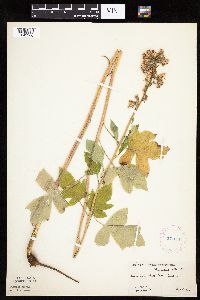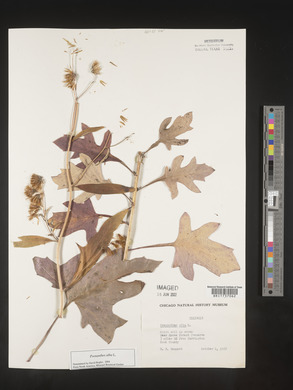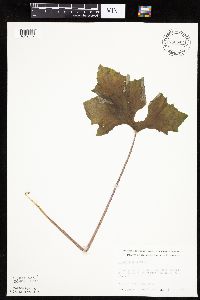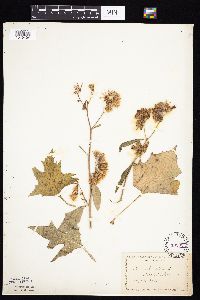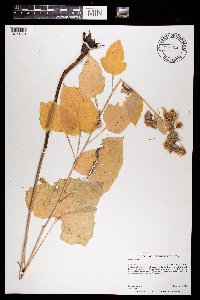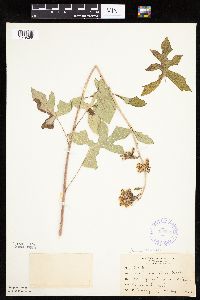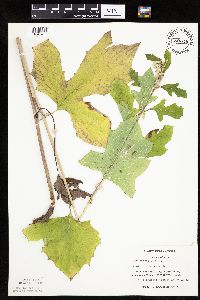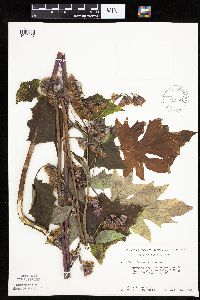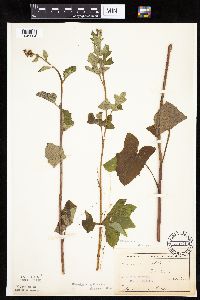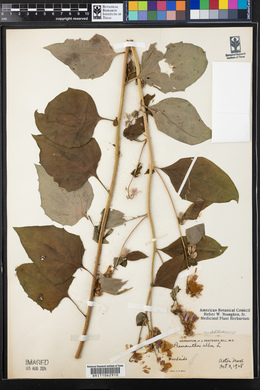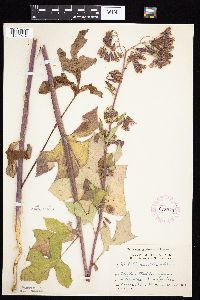Nabalus albus
|
|
|
|
Family: Asteraceae
White Rattlesnake-Root, more...White Rattlesnake-Root
[Prenanthes alba L., morePrenanthes alba subsp. alba , Prenanthes alba subsp. pallida Milstead, Prenanthes alba var. alba L., Prenanthes alba var. pallida Milstead, Prenanthes miamiensis Riddell] |
Plants 20-175 cm; taproots short and thickened, fibrous. Stems erect, often mottled purple or nearly all purple (often with stout bases, 8-12 mm diam.), proximally glabrous, tomentulose distally. Leaves: proximal present at flowering; petioles narrowly winged (to 18 cm); blades usually ovate to triangular or cordate, 4-30 × 3-18 cm, thin to coriaceous, bases often hastate, margins usually coarsely dentate or serrate, sometimes deeply 3-lobed or parted, lobes acute, faces glabrous adaxially, pale to whitish and sometimes hirsute abaxially; distal reduced. Heads (3-8, in clusters) in paniculiform arrays (densest near apices). Involucres cylindric to campanulate, 13-15 × 3-5 mm. Calyculi of 5-7, triangular to lanceolate bractlets 1-3 mm, glabrous. Phyllaries (6-)8(-9), ± purplish or maroon, lanceolate, 10-13 mm, margins scarious, minutely ciliate, apices acute, faces glabrous. Florets 7-9(-13); corollas whitish to pale pink, lavender or red, 9-15 mm. Cypselae brown or tan, elliptical to linear, 3.5-6 mm; pappi usually reddish brown, sometimes rusty, rarely yellowish, 6-7 mm. 2n = 32. Flowering Aug-Oct. Sandy oak-scrub, open oak-hickory woods, deciduous forests, dunes, creek banks, road cuts; 100-200 m; Man., Ont., Que., Sask.; Ark., Conn., Del., Ga., Ill., Ind., Iowa, Ky., Maine, Md., Mass., Mich., Minn., Mo., N.H., N.J., N.Y., N.C., N.Dak., Ohio, Pa., R.I., S.Dak., Tenn., Vt., Va., W.Va., Wis. Prenanthes alba is recognized by the purplish stems, relatively large, coarse, ovate or triangular leaves, relatively long, winged petioles, glabrous and often purple phyllaries, and usually reddish brown pappi. The leaves are variable, occasionally deeply 3-lobed. W. L. Milstead (1964) recognized specimens with a pale yellow pappi as 'subsp. pallida,' distributed on the east coast in New Jersey, Virginia, and North Carolina. Because pappus color tends to fade somewhat on herbarium specimens, that character is difficult to assess on older specimens. The name was not validly published.
Stem stout, 4-17 dm; herbage ±glaucous; lvs glabrous above, often hairy beneath, highly variable in size and shape, the lower long-petioled, palmately or pinnately few-lobed to sagittate or hastate-reniform and merely coarsely toothed, becoming smaller, less cut, and less petiolate upward; infl elongate-paniculiform; heads nodding; invol 11-14 mm, with mostly 8 principal bracts, these glabrous, generally somewhat purplish, ±densely papillate with white, waxy- appearing cells that are usually distinguishable at 10 reduced outer bracts, as in no. 4 [Prenanthes serpentaria Pursh], mostly a little longer and narrower than in no. 5 [Prenanthes trifoliolata (Cass.) Fernald]; fls 9-11(-15), mostly white to pinkish or lavender; pappus cinnamon- brown; 2n=32. Woods; Me. to Man., s. to N.C., W.Va., and Mo. Aug., Sept. Gleason, Henry A. & Cronquist, Arthur J. 1991. Manual of vascular plants of northeastern United States and adjacent Canada. lxxv + 910 pp. ©The New York Botanical Garden. All rights reserved. Used by permission. From Flora of Indiana (1940) by Charles C. Deam This species has its mass distribution in the lake area, becoming local southward. It is rather infrequent in the lake area and is found mostly in moist, sandy soil in woodland and sometimes in marshes. This plant has a common name assigned to it which rightfully belongs to another plant. Since the other plant is a medicinal plant it claims the common name, and, since it is confusing to have two plants with the same common name, I do not mention it here. …… Indiana Coefficient of Conservatism: C = 5 Wetland Indicator Status: FACU |








